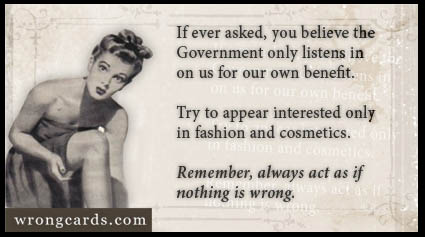march  2009
2009
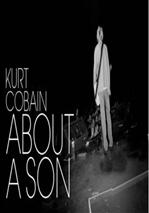 While I was getting ready for work yesterday, I watched this Grunge Documentary that aired a while back on VH1. It was truly a readers' digest version compared to others like Hype! (1996) and the more recent About a Son, a hauntingly grunge-free series of intimate, informal conversations with Kurt Cobain, collected over almost ten years and paired with a stark, atmospheric montage of the Pacific Northwest that keeps perfect pace with the dialogues that carry us from his childhood to within months of his death.
While I was getting ready for work yesterday, I watched this Grunge Documentary that aired a while back on VH1. It was truly a readers' digest version compared to others like Hype! (1996) and the more recent About a Son, a hauntingly grunge-free series of intimate, informal conversations with Kurt Cobain, collected over almost ten years and paired with a stark, atmospheric montage of the Pacific Northwest that keeps perfect pace with the dialogues that carry us from his childhood to within months of his death.
The photo selections are anything but random, forming a parallel narrative. The opening scenes unfold at an almost torturous crawl, meandering through the damp, depressing town of Aberdeen, drifting aimlessly down gravel roads, through lumber yards and diners.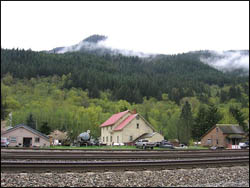 The shifting images pick up speed as we descend down I-5 into Seattle's northern outskirts and the featureless expanses of highway that were then also the Green River Killer's hunting grounds; finally we're on the streets of Pioneer Square, rolling past laughably inauspicious entrances to infamous holes in the wall where this particular chapter of music history was largely written.
The shifting images pick up speed as we descend down I-5 into Seattle's northern outskirts and the featureless expanses of highway that were then also the Green River Killer's hunting grounds; finally we're on the streets of Pioneer Square, rolling past laughably inauspicious entrances to infamous holes in the wall where this particular chapter of music history was largely written.
When "About a Son" was first released I read a particularly snarky review in one of the weekly papers and, based on little more than the critic's writing style, concluded that I would probably not enjoy it either. It sounded very much like something I imagined I would write if I had to review a film that failed to do justice to a subject close to my heart. I even read a few of the more scathing sentences out loud to Mr. Pink and a friend, prompting nods of sympathetic agreement. Well, lucky for me, Mr. Pink isn't as easily influenced by a few snarky sentences in a free tabloid as I am, because just a few weeks later he brought the DVD home from the store and, about 15 minutes into watching it, I announced that a certain critic was dead to me.
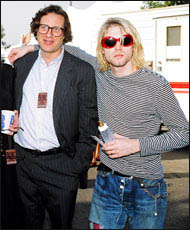 Author and record company executive Danny Goldberg also had a lot to say about Kurt when he gave a talk at Google to promote his book "Bumping Into Geniuses: My Life Inside the Rock and Roll Business." This was partly due to the fact that he considers Kurt one of the titular "geniuses" of rock but it's also because the audience rather shamelessly asked one question after another about Nirvana, barely grazing such luminaries as Led Zeppelin, Stevie Nicks and KISS, about any one of whom Goldberg could have regaled them with personal anecdotes.
Author and record company executive Danny Goldberg also had a lot to say about Kurt when he gave a talk at Google to promote his book "Bumping Into Geniuses: My Life Inside the Rock and Roll Business." This was partly due to the fact that he considers Kurt one of the titular "geniuses" of rock but it's also because the audience rather shamelessly asked one question after another about Nirvana, barely grazing such luminaries as Led Zeppelin, Stevie Nicks and KISS, about any one of whom Goldberg could have regaled them with personal anecdotes.
Back to the enigmatically titled Grunge Documentary that I watched yesterday. I did learn one thing that I should have known all along as a matter of record (no pun intended) but that I had somehow never internalized until now; the album Nevermind was actually released the very same month that I started college. It was the first week of September 1991 and I had just arrived in Baltimore, cramming all my worldly possessions into the smallest of four bedrooms in a 3-story row house apartment building reserved for first-year students at the nearby Maryland Institute, College of Art.
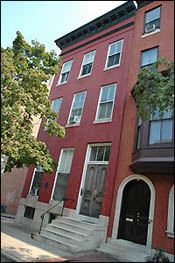 Trite as it sounds, I can actually remember where I was (tiny, cramped bedroom surrounded by a mountain of half-unpacked boxes) and what I was doing (sweating profusely, trying to figure out how to dress for 90 degree heat/90% humidity) the first time I heard Smells Like Teen Spirit. I actually "stopped in my tracks." I turned and stared at the radio as if I were in a commercial. I only caught the second half of it but that was enough for me to know I loved it.
Trite as it sounds, I can actually remember where I was (tiny, cramped bedroom surrounded by a mountain of half-unpacked boxes) and what I was doing (sweating profusely, trying to figure out how to dress for 90 degree heat/90% humidity) the first time I heard Smells Like Teen Spirit. I actually "stopped in my tracks." I turned and stared at the radio as if I were in a commercial. I only caught the second half of it but that was enough for me to know I loved it.
When the song abruptly came to an end, I listened for the band's name and then found myself cursing the DJ whose Baltimoron erudition was such that I almost caught two indecipherable syllables before the opening chords of Joyride by Roxette blotted out all other sounds. I momentarily despaired of ever finding out who played my new favorite song. But of course, we all know I needn't have worried; pretty soon everyone in the world would know who they were.
A short time later I learned that the band's name was Nirvana and that they were from Seattle, where I had spent my formative 5th-9th grade years (okay, the Seattle area but that's how they said it back then). I had left Seattle just three years before, when my parents felt compelled to move to the East Coast. We had crossed the country via the Ogden-Denver-St. Louis-Kansas-Kentucky route and arrived in central Virginia (Thomas Jefferson country) just in time for the first week of September, where I got my first taste of that peculiar East Coast combination of ungodly stifling heat in the 90-degree range and 100% humidity without a drop of precipitation.
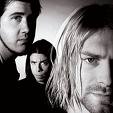 So I immediately called my best friend who still lived in Seattle and of course — heh, like an idiot — asked if he knew them. As it turned out he kind of did — or at any rate, he'd seen them around at local bars and house parties — they were several years older than us but he knew people who had gone to school with at least one of them.
So I immediately called my best friend who still lived in Seattle and of course — heh, like an idiot — asked if he knew them. As it turned out he kind of did — or at any rate, he'd seen them around at local bars and house parties — they were several years older than us but he knew people who had gone to school with at least one of them.
And here I was living in Baltimore, surrounded by art students from Philadelphia and New Jersey, one of only two of that year's freshmen who hailed from the West Coast. (The other was my roommate and she was from Eugene, Oregon. When we went to the art supply store on campus together, the manager would always shout "California!" and flash the "hang ten" sign at us, as if we were in the same gang or something.) It would be another year and a half before I acted on the impulse but it's possible that, somewhere in the back of my mind where Nevermind was now playing on perpetual repeat, I had already started formulating a plan to return to Seattle.
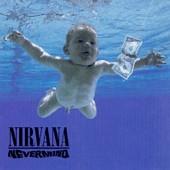 It was about six months into the meteoric rise of Nevermind when Tori Amos' cover of Smells Like Teen Spirit came out. At first everyone was like: who is this chick? The next thought: oh my god, that's what they're saying! You were tempted in that first moment to think it was a bit of a sacrilege but it was just too perfect. Her voice was like a crystal chime, sweet and high and powerful, lilting and lingering with obvious reverence and piercing through the feedback and rage of the original to infuse his emotion-laden lyrics with unearthly beauty.
It was about six months into the meteoric rise of Nevermind when Tori Amos' cover of Smells Like Teen Spirit came out. At first everyone was like: who is this chick? The next thought: oh my god, that's what they're saying! You were tempted in that first moment to think it was a bit of a sacrilege but it was just too perfect. Her voice was like a crystal chime, sweet and high and powerful, lilting and lingering with obvious reverence and piercing through the feedback and rage of the original to infuse his emotion-laden lyrics with unearthly beauty.
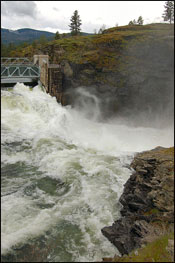 In June 1993 I found myself crossing the country again, this time taking the considerably cooler northerly route, after a detour to Ontario, down to the Detroit-Windsor border crossing and looping around Chicago where, sadly, the suburbs are so prodigious that there isn't a single vantage point from the massive concrete gyre skirting the city where you can see so much as the tip of the nation's tallest building.
In June 1993 I found myself crossing the country again, this time taking the considerably cooler northerly route, after a detour to Ontario, down to the Detroit-Windsor border crossing and looping around Chicago where, sadly, the suburbs are so prodigious that there isn't a single vantage point from the massive concrete gyre skirting the city where you can see so much as the tip of the nation's tallest building.
Worse than that, performing this high-speed slingshot maneuver around the galactic hub of Chicago without being pulled into its orbit is half a day's drive in perpetual rush-hour conditions. Fortunately, by the time you've reached escape velocity and it's safe to scope out a place to stop for the night, you're in the heart of Wisconsin, one of the most charming, hospitable states in the Union.
If you have a choice, though, I wouldn't recommend making the trip on a Fourth of July weekend. They're just as friendly then as ever but they'll be shaking their heads sadly when they smile at you and say, "Oh no... I am. so. sorry. but we're all booked up! You want to go back out the drive, same way you came, hang a left and get on the highway, go maybe six miles or so..."
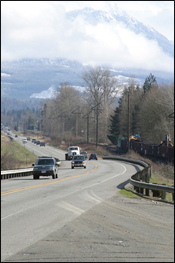 So you you make your way over the wind-whipped steppes of Fargo, Butte, Missoula and the terrifying water-diverting system of mammoth dams and falls in the northernmost finger of Idaho that pokes up between Montana and Washington state, until finally you cross the last border and blindly speed as fast as your rented minivan will fly across the wide, dry, desolate glacier-scape of Eastern Washington.
So you you make your way over the wind-whipped steppes of Fargo, Butte, Missoula and the terrifying water-diverting system of mammoth dams and falls in the northernmost finger of Idaho that pokes up between Montana and Washington state, until finally you cross the last border and blindly speed as fast as your rented minivan will fly across the wide, dry, desolate glacier-scape of Eastern Washington.
Then there's a moment when you know you've finally made it. All that remains is the steep, twisty, harrowing careen down the west side of the Cascade Mountains into a damp, railroad-carved canyon of forests watercolored in every shade of green. Haphazard buildings cling to the mountains surrounding the highway like clumps of peat-moss, remnants of long-forgotten towns in steady decline after the gold rushes of a forgotten century.
Unfortunately, my first year back in Seattle was relentlessly depressing; I got a job at the Space Needle and spent a year working 4 pm to 12 am five nights a week, the solitary confinement shift, in the tourist attraction's kitschy gift shop. Meanwhile my partner was in 9-5 commission-sales purgatory — waiting for what had seemed like a dream job to start paying off. So, even though we were both working full time, we never saw each other and we could barely afford to buy groceries, let alone partake of the music scene for which the city was now world-renowned.
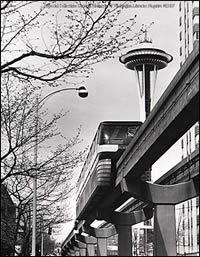 In January 1994, I had traded someone for an 11 am -7 pm shift in the observation-level gift shop when one of my friends, a chef at the infamously overpriced revolving restaurant, came bounding over to the counter and breathlessly announced that Nirvana was playing that night at the Seattle Center Arena. He wiped sweat from his forehead and stared at me expectantly. "We've gotta go!" But how are we going to get tickets? It has to be sold out...
In January 1994, I had traded someone for an 11 am -7 pm shift in the observation-level gift shop when one of my friends, a chef at the infamously overpriced revolving restaurant, came bounding over to the counter and breathlessly announced that Nirvana was playing that night at the Seattle Center Arena. He wiped sweat from his forehead and stared at me expectantly. "We've gotta go!" But how are we going to get tickets? It has to be sold out...
"Doesn't matter," he interrupted with a grin, brimming with a confidence I can only describe as uniquely Sagittarian. "We'll find tickets. There are always tickets." But, I said, hesitating long enough to interrupt his bubbling stream of consciousness — hating that my excuses had become such predictable cliches, so easy and automatic that he had already begun mocking what I would say next — I can't afford it. "Don't say that," he pleaded. "You've never seen Nirvana in concert and you don't know when you'll have another chance." I tilted my head as if to say, Oh sure, they're only from Seattle... but his face was dead-serious; "Come on. Don't miss this."
Looking back on this scene from my privileged vantage point, in a then-unimaginable dystopic future, it pains me beyond measure to describe what happened next. I stared at my friend who, still sweating from his day behind the line in the city's busiest kitchen, was now hunching down over the cash register to meet my eye level. I imagined standing out there in the cold January night watching him haggle with seedy-looking ticket scalpers. I thought about what the tickets would cost and how he would tell me not to worry about it, as he often did when he arrived at our apartment to make lunch or share a bottle of vodka. I thought about my partner, who was just getting home from the job where he had still not received a single commission and was now embroiled in a dispute with his employer that would eventually force him to leave the company, empty-handed and embittered.
"I can't." I might have even added something about "next time," but that could also just be my memory fucking with me, embellishing the moment in hindsight from one of simple but profound regret into one of epic, easily foreseeable regret, charged with electrical intensity and heavy-handed foreshadowing. My friend reluctantly left me to my customers and their tacky, overpriced souvenirs and, when I mentioned it to my partner later that night, of course he said, "Oh, you should go with your friend." But there was something about the way he said your friend that reinforced my unspoken reasons for deciding not to go.
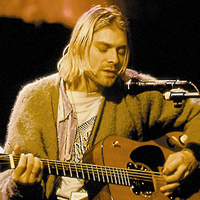 Three months later, to the day, I was getting ready for work and I turned on the radio in the living room. They were playing a track from Nirvana's Unplugged album, recorded the previous September. I turned it up and, having the place to myself, I sang along. Instead of fading out or cutting to commercial at the end of that song, it went right into the next track and I wondered if the DJ was on a bathroom break or if they were going to play the whole album. They had been promoting it heavily on MTV for months but I still wasn't tired of it so this seemed like a great prospect.
Three months later, to the day, I was getting ready for work and I turned on the radio in the living room. They were playing a track from Nirvana's Unplugged album, recorded the previous September. I turned it up and, having the place to myself, I sang along. Instead of fading out or cutting to commercial at the end of that song, it went right into the next track and I wondered if the DJ was on a bathroom break or if they were going to play the whole album. They had been promoting it heavily on MTV for months but I still wasn't tired of it so this seemed like a great prospect.
When the next song they played was a track off of Nevermind, I felt a premonitory chill race down my back. It had only been a month since Kurt Cobain's near-overdose in Rome sent fans around the world into a 24-hour deathwatch, holding our collective breath for word that he had come out of the coma induced by an uncharacteristic mix of alcohol and Rohypnol. (It would later come out that he had written a suicide note before he ingested a mind-boggling 50 individually blister-packaged pills and washed them down with champagne.)
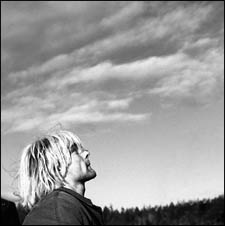 After the fourth Nirvana song in a row, the DJ came on and reported the partial story that would soon be repeated countless times with ever-increasing detail and certainty as the day progressed. Rumors had been circulating all morning after a local radio station received a phone call from an electrician with a story about his colleague who had arrived to do some work at Cobain's house and found "a body" lying on the floor of a building on the property. The station had contacted the police but at that point they still hadn't officially confirmed the report. Then the story began to be picked up by other stations and local news outlets. At one point, I got up to scan around the other radio stations to see if anyone had some new information. It seemed like they were all just playing one Nirvana song after another; even the pop stations would play In Bloom or something, updating the story every hour between Top 40 sets.
After the fourth Nirvana song in a row, the DJ came on and reported the partial story that would soon be repeated countless times with ever-increasing detail and certainty as the day progressed. Rumors had been circulating all morning after a local radio station received a phone call from an electrician with a story about his colleague who had arrived to do some work at Cobain's house and found "a body" lying on the floor of a building on the property. The station had contacted the police but at that point they still hadn't officially confirmed the report. Then the story began to be picked up by other stations and local news outlets. At one point, I got up to scan around the other radio stations to see if anyone had some new information. It seemed like they were all just playing one Nirvana song after another; even the pop stations would play In Bloom or something, updating the story every hour between Top 40 sets.
By early afternoon, the official story had circulated throughout the city, filtering down from the rock stations to all the other local media long before it was finally announced to the world by Kurt Loder in an MTV Special Report. The radio stations in Seattle would continue their memorial marathon for months, long after the story had faded from the front pages of the local papers.
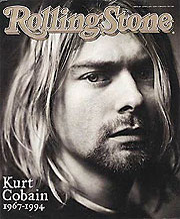 Two days after Kurt Cobain's body was found, there was a memorial service at the Seattle Center Flag Pavilion. Even if I had wanted to avoid it, it would have been impossible since it was happening right in the middle of my way to work — but of course, I didn't want to avoid it. What I did manage to do, however, was arrive just in time to miss what the other 5,000-7,000 attendees had ostensibly come to hear; a taped message from the grieving Courtney Love, in which she read parts of his suicide note to his stricken fans ("considering that it's addressed to most of you"). I heard bits and pieces of the recording later and realized that I probably had very good reasons for subconsciously delaying my arrival. I could easily imagine feeling haunted by her overwhelming grief and living with the echo of her words in my head, if I had been there to hear them firsthand.
Two days after Kurt Cobain's body was found, there was a memorial service at the Seattle Center Flag Pavilion. Even if I had wanted to avoid it, it would have been impossible since it was happening right in the middle of my way to work — but of course, I didn't want to avoid it. What I did manage to do, however, was arrive just in time to miss what the other 5,000-7,000 attendees had ostensibly come to hear; a taped message from the grieving Courtney Love, in which she read parts of his suicide note to his stricken fans ("considering that it's addressed to most of you"). I heard bits and pieces of the recording later and realized that I probably had very good reasons for subconsciously delaying my arrival. I could easily imagine feeling haunted by her overwhelming grief and living with the echo of her words in my head, if I had been there to hear them firsthand.
By the time I got there, they had already taken down the public address system which had amplified her breaking voice over thousands of bowed heads. The memorial had dispersed and people were now milling around in small groups, holding hands or lighting candles, a sea of tear-streaked faces obscured by unkempt hair in every color of the rainbow. I drifted around the edges of the crowd, through the gates of the normally festive Flag Pavilion towards the fountain in which I had many fond memories of frolicking as a little girl. Evidently those memories were not unique. I stood at a distance and watched as the central dome housing the fountain's impressive array of nozzles disappeared beneath the well-worn Converse All-Stars of a legion of fans.
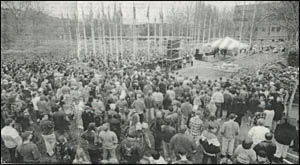 They were emotionally exhausted, having absorbed and reflected back the uncensored anguish of Courtney's words, and awash in their own feelings of loss, confusion and anger, they were now drawn to a powerful symbol of the joyful innocence of childhood. They abandoned themselves to the rapture of the fountain in an unmistakably Piscean ritual of cleansing and release, dancing and laughing as soaring arcs of water drenched them and the wind carried clouds of glittering, rainbow-studded mist out across the pavilion.
They were emotionally exhausted, having absorbed and reflected back the uncensored anguish of Courtney's words, and awash in their own feelings of loss, confusion and anger, they were now drawn to a powerful symbol of the joyful innocence of childhood. They abandoned themselves to the rapture of the fountain in an unmistakably Piscean ritual of cleansing and release, dancing and laughing as soaring arcs of water drenched them and the wind carried clouds of glittering, rainbow-studded mist out across the pavilion.
My face damp with mist, I smiled sadly and wandered around a bit more, making occasional eye contact but mostly just observing. I probably didn't look like someone who was there to mourn anyway, dressed as I was, in the black pants and polyester uniform blouse that I had to wear for work. The background roar from the fountain's powerful jets suddenly dropped into a lower register, causing an uncoordinated bellow of disapproval to erupt from the reveling mourners (or were they mourning revelers?). The highest plumes of water geared-down to about half their previous height and, despite the protesting cries of the sodden crowd, they continued to shift ever lower.
 Within a few minutes, only a dozen or so people remained standing at the center of the fountain, looking perplexed amid the spiky array of nozzles, some of which were as high as their knees. A few jets of water still sputtered and bubbled fitfully around their ankles. They looked like mannequins in a grunge fashion display. Like someone had tried to light a cigarette and set off the sprinkler system, triggering a deluge. One of the guys sat down cross-legged and started trying to set his shoelaces on fire with a wet lighter. I slowly started walking back in the direction of the Space Needle.
Within a few minutes, only a dozen or so people remained standing at the center of the fountain, looking perplexed amid the spiky array of nozzles, some of which were as high as their knees. A few jets of water still sputtered and bubbled fitfully around their ankles. They looked like mannequins in a grunge fashion display. Like someone had tried to light a cigarette and set off the sprinkler system, triggering a deluge. One of the guys sat down cross-legged and started trying to set his shoelaces on fire with a wet lighter. I slowly started walking back in the direction of the Space Needle.
"What began with a minister's moment of silence and tearful eulogies exploded into a showdown of teenage angst and rebellion." Seattle Times, Milestones (2002)
You know, the problem with the Internet — and maybe with the world, generally, as it is today — is that you can find almost any event you experienced in real life online somewhere, immortalized in newspaper stories or other people's Flickr collections or the online archive of your alma mater's yearbooks that go back three generations. You'll be looking for some event from your past — Kurt Cobain's Memorial on April 10, 1994, for example — and maybe it looks the way you remember it, maybe it doesn't. The point is, after a while you realize you're not looking for something you remember seeing back then. You're looking for YOU. You know you were there and maybe you don't remember seeing any cameras but who's to say there couldn't be some random photo out there of you? That you couldn't actually stumble across yourself somewhere along Memory Lane. Proving what, exactly? That it really happened? That you're woven into the fabric of history? That your stalker knows how to use Photoshop?
Anyway, this isn't a problem, just a digression. If there was a life lesson encoded in this story, it would probably be more about how I wasn't really there, even when I was.
The day after the memorial, both of the city papers carried the story on the front page. I saw them as I was walking down Queen Anne Hill to work; the Seattle Times had a photo of a bunch of kids in shredded jeans and flannel splashing around in the fountain. Beside it was the inconsonant headline: "Fountain of teen spirit for Kurt Cobain." It couldn't have been any worse if they had run the words that were not quite yet, but soon would be, on everyone's lips: Grunge is Dead.
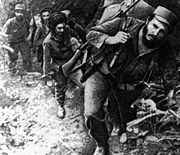
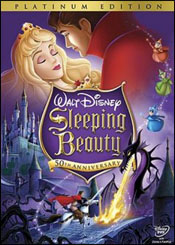 Fidel Castro's revolutionaries arrive in Havana, Cuba in January, replacing the Batista government. Sleeping Beauty, my all-time favorite Disney movie is released January 29th and Barbie debuts March 9th. February 3rd, "the day the music died," Buddy Holly, Ritchie Valens, The Big Bopper and pilot Roger Peterson are killed when their plane crashes in heavy fog.
Fidel Castro's revolutionaries arrive in Havana, Cuba in January, replacing the Batista government. Sleeping Beauty, my all-time favorite Disney movie is released January 29th and Barbie debuts March 9th. February 3rd, "the day the music died," Buddy Holly, Ritchie Valens, The Big Bopper and pilot Roger Peterson are killed when their plane crashes in heavy fog.
The Tibetan Uprising against Chinese occupation begins on March 10, 1959; the violence escalates, ultimately leading to the flight and subsequent 50-year exile of His Holiness the Dalai Lama and the deaths of over 86,000 Tibetans.
In July, the first Australopithecus skull is discovered in Tanzania by Louis and Mary Leakey and the first two Americans are killed in action in Vietnam. The first human death from HIV is recorded in the Congo. Also in the Congo, riots break out in Leopoldville simultaneous with the Cuban Revolution, eventually leading to elections the following year and the Republic of Congo declaring independence on June 30, 1960. Cyprus and Singapore also gain their independence in 1959 and Alaska and Hawaii are admitted as the 49th and 50th US states.
From "Today in History" to a Random Bunch of Links
Ah well, at least I'm updating...
Here's an interesting piece from a site with an even more interesting name, Top Ten Myths About Astrology from starfuckersastrology.com, but I'm going to hold off on the "couldn't have said it better myself" endorsement until I figure out exactly what they have against Virgos. Oh, yeah — and since when are we allowed to use the f-word in domain names? When did this happen? And how is it that you can have the word fuck in the name of your web site but if you edit it in Dreamweaver, the spell check still doesn't know it's a fucking word?
Okay. So, last year I was all excited when I came across this thing about how a million seconds was ten days ago and a billion seconds ago was during the Carter administration and a trillion seconds ago was 31,000 years ago when Neanderthals were wandering around. I thought that was a cool little exercise to get your mind around exactly how fucking much a trillion is — forget about all that — and you can also forget about that Senator with his little posters demonstrating how far a trillion dollar bills placed end-to-end would stretch into space. This is WAY better.
There's a rare but uniquely satisfying phenomenon that occurs when, as an adult, you're presented with the unexpected opportunity to revise, update, correct, clear up, flesh out or fill in the blanks of some outdated narrative you've been holding about the world, often unconsciously, since childhood.
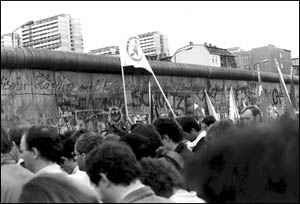 For most of the big, world view-altering events that redraw everyone's internal maps all at once, we have a spectacular set of shared memories, a mosaic of collective recollections — say, the Berlin Wall in 1989 — that mark the "moment" of change.
For most of the big, world view-altering events that redraw everyone's internal maps all at once, we have a spectacular set of shared memories, a mosaic of collective recollections — say, the Berlin Wall in 1989 — that mark the "moment" of change.
Other changes are more gradual but no less obvious, like China's slow but steady transformation into an economic superpower which, despite a dearth of "free press," has been playing out for decades on the world stage.
 Some of the narratives that helped to shape our earliest conceptions of the world have proved so enduring as to remain in perpetual rotation, top stories on the evening news for as long as we can remember. Decades have passed and empires have crumbled but the US blockade of Cuba and, indeed -- at least at the time of this writing -- the Father of the Revolution, live on. In the last 60 years, we split the atom and decoded the genome; sent robots to explore the surface of Mars and photographed the birth of stars in distant galaxies for our coffee table books but Israel and Palestine are still at war and Tibet is still under occupation. If it wasn't so damned disheartening it might provide a sort of comforting continuity, knowing that we could have slipped into a coma for ten years and awakened to find that at least these things were still true.
Some of the narratives that helped to shape our earliest conceptions of the world have proved so enduring as to remain in perpetual rotation, top stories on the evening news for as long as we can remember. Decades have passed and empires have crumbled but the US blockade of Cuba and, indeed -- at least at the time of this writing -- the Father of the Revolution, live on. In the last 60 years, we split the atom and decoded the genome; sent robots to explore the surface of Mars and photographed the birth of stars in distant galaxies for our coffee table books but Israel and Palestine are still at war and Tibet is still under occupation. If it wasn't so damned disheartening it might provide a sort of comforting continuity, knowing that we could have slipped into a coma for ten years and awakened to find that at least these things were still true.
But not all our internal imprints were "big picture" compositions; many of those seemingly permanent states of the world in which we grew up changed over time without our noticing, either slowly and imperceptibly or suddenly but somehow strangely unreported.
When I was growing up in the late seventies and early eighties, New York City seemed an almost mythological place, a distant projection and distillation of the nation's seediest desires and darkest excesses. In fiction, it was an impenetrable forest of concrete in which only the fiercest, most battle-hardened characters survived. On the nightly news it was the backdrop to an endless stream of stories that, to a child, seemed the stuff of which all effective cautionary tales are made. Its very name conjured up images of knife-wielding gangs running wild in trash-strewn alleys, of streets lined with boarded up tenements guarded by menacing thugs; of parks where faceless, trench-coated maniacs lurked in the shadows and abandoned waterfront warehouses where things went on that were so awful they couldn't even be reported.
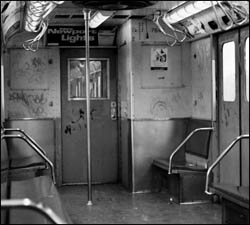 Various narratives have attempted to bridge the divide between the New York of "Escape from New York" and the city it is today, arguably the most civilized, cosmopolitan and connected to the wider world that North America has to offer. Rudy Giuliani, of course, credits his own administration and its driftnet approach to policing. Malcolm Gladwell credits small but influential changes in the environment, citing a campaign to clean up the subways which, once scrubbed of graffiti, were eventually reclaimed from would-be vandals. Stephen Dubner and Steven Levitt, co-authors of Freakonomics, credit Roe vs. Wade for the precipitous drop in crime in the 1990s, arguing that the 1973 decision to legalize abortion effectively erased an entire generation of unwanted children who would otherwise have been born into poverty and familial dysfunction and, 20 years later, would have grown into society's most dispossessed and dangerous criminals.
Various narratives have attempted to bridge the divide between the New York of "Escape from New York" and the city it is today, arguably the most civilized, cosmopolitan and connected to the wider world that North America has to offer. Rudy Giuliani, of course, credits his own administration and its driftnet approach to policing. Malcolm Gladwell credits small but influential changes in the environment, citing a campaign to clean up the subways which, once scrubbed of graffiti, were eventually reclaimed from would-be vandals. Stephen Dubner and Steven Levitt, co-authors of Freakonomics, credit Roe vs. Wade for the precipitous drop in crime in the 1990s, arguing that the 1973 decision to legalize abortion effectively erased an entire generation of unwanted children who would otherwise have been born into poverty and familial dysfunction and, 20 years later, would have grown into society's most dispossessed and dangerous criminals.
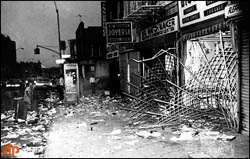 If you missed all the stuff in the middle, the transformation seems miraculous and makes you wonder what was really going on back in the bad old days — since, if we really stop and analyze it, our memories of that time are unavoidably intertwined with fragments from Taxi Driver (1976), The Warriors (1979) and, yes, Escape from New York (1981). I remember finding a book in the school library when I was in 5th grade (1983-ish). It was set in a futuristic New York so overrun with filth and crime that the entire population of Manhattan would abandon and seal off the city every summer. The main character was a kid who got left behind and had to struggle to survive for three months pursued by gangs and wild animals.
If you missed all the stuff in the middle, the transformation seems miraculous and makes you wonder what was really going on back in the bad old days — since, if we really stop and analyze it, our memories of that time are unavoidably intertwined with fragments from Taxi Driver (1976), The Warriors (1979) and, yes, Escape from New York (1981). I remember finding a book in the school library when I was in 5th grade (1983-ish). It was set in a futuristic New York so overrun with filth and crime that the entire population of Manhattan would abandon and seal off the city every summer. The main character was a kid who got left behind and had to struggle to survive for three months pursued by gangs and wild animals.
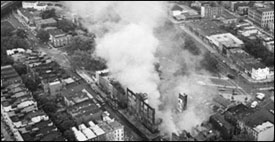 Thinking about it now, even though I understood that it was science fiction — a genre I fully appreciated in Star Trek, Stephen King, The X-Men — there was something about the matter-of-fact anonymity of this novel that may have bypassed my 10-year old brain's genre-sorting mechanism, situating itself next to seemingly similar story-fragments — the Central Park jogger, Bernie Goetz and the Blackout riots.
Thinking about it now, even though I understood that it was science fiction — a genre I fully appreciated in Star Trek, Stephen King, The X-Men — there was something about the matter-of-fact anonymity of this novel that may have bypassed my 10-year old brain's genre-sorting mechanism, situating itself next to seemingly similar story-fragments — the Central Park jogger, Bernie Goetz and the Blackout riots.
(Photos found at 1970's New York City - Wired New York Forum.)
This week, I watched a documentary called "Nightmare In The City That Never Sleeps" and finally filled in some of those gaps. Excerpt:
"Today New York is America's greatest city. But 30 years ago this summer, they couldn't even keep the lights on. A blackout plunged seven million people into darkness. Then the nightmare began." (Best Free Documentaries)
An ominous postscript discovered in the course of my scrounging the Internet, fruitlessly, I might add, to find the name of that book from 5th grade, a Reuters article from this year entitled New York City fears return to 1970s. Excerpt:
"The 1970s were a low point in city history as a fiscal crisis almost pushed it into bankruptcy, crime rates soared, and homeless people crowded sidewalks as public services crumbled." [Fast forward to 2009,] "there are signs of a city under growing stress, including a rise in homelessness that's driving more families to shelters and last year's 57 percent spike in bank robberies... 444 compared with 283 in 2007. As city revenues slide with the demise of Wall Street firms, the mayor... has slashed spending by all agencies and there's more to come. Wall Street's financial industry is one of the city's biggest taxpayers but it has lost more than $36 billion in the last two years and may eventually shrink its work force by a quarter, the mayor said." (Reuters)
While we're on the topic of social and economic collapse (oh, I know — when are we not?)... Ever since I discovered Dmitry Orlov's "Closing the Collapse Gap" (also via free documentaries) last fall, I've been raving about him fairly frequently and sending his articles out to friends and family. Now instead of listening to my five-minute spiel ("You know, like the Missile Gap?"), you can watch Dmitry Orlov's Social Collapse Best Practices presentation at the Long Now Foundation which has been on the "most watched" list at FORA.tv for two weeks now.
